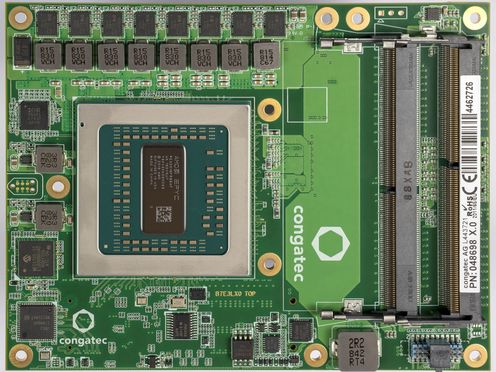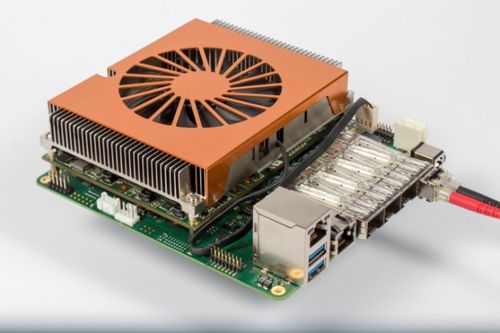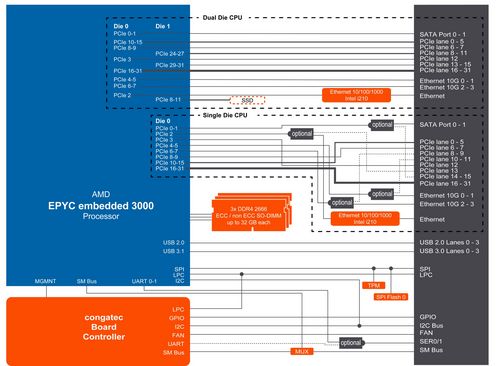
COM Express Type 7 with AMD EPYC Embedded 3000 processors
Performance boost for harsh environments

Server processors are getting more and more energy efficient. Embedded application developers use them to boost performance, which also opens up completely new application fields for them. congatec supports such OEM designs with application-ready COM Express Type 7 modules and platforms. The conga-B7E3 Server-on-Module with AMD EPYC 3000 Embedded processor currently tops the embedded server class.
The embedded computing market is demanding more computing power across many application areas: Industry 4.0 applications require synchronization of multiple machines and systems; machine vision in collaborative and cooperative robotics requires processing of image and other environmental data. The same applies to autonomous robotic and logistics vehicles. Many of the edge computing tasks that arise around the development of 5G networks require server class performance by default. Not to mention the growing need to install virtualized on-premise equipment (vOPE) in harsh environments to perform functions such as industrial routing, firewall security, and VPN technologies through software alone on mostly generic embedded hardware.
Added benefit: More convenient remote management
It isn’t only in this context that the ability to manage embedded systems remotely – both on the fly and out-of-band – is growing in importance. New fields of application such as interference systems for artificial intelligence (AI) also demand a lot of computing performance. System consolidation through virtualization with hypervisor technologies increases the demand for more embedded system performance still further.
All of these application fields call for a new performance class at the embedded server level, which classic embedded computer technology was traditionally unable to deliver as it tends to cater only for up to about 50W. The number of cores as well as the bandwidth and number of high-performance interfaces was simply too small, and comprehensive remote management features were missing. However, processor manufacturers such as AMD have made their server technologies increasingly efficient in recent years and now also offer multiprocessor systems in TDP classes, which already offer all the functions that can be expected from server processors in the 30-100W class.
Extremely energy-efficient 30W servers
30W embedded server technology enables completely passively cooled systems in robust designs thanks to soldered processors coupled with all RAS (reliability, availability and serviceability) features known from the classic server segment. At the same time, it doesn’t provide too much functionality – especially not the comprehensive graphics support of APUs that integrate the CPU and GPU on a single die – so there’s no need to retain unnecessary resources.
The AMD EPYC Embedded 3000 processor family is at the cutting edge of this new class of embedded server processors, offering 4, 8, 12, or 16 high-performance cores, simultaneous multi-threading (SMT) support, up to 1TB DDR4 memory (over 4 channels), and up to 64 PCIe Gen 3 lanes. Compared to traditional solutions available on the market, it supports 52% more instructions per clock and twice the connectivity. Besides all of this, AMD also provides up to 2.7x more power per dollar. All in all, these are convincing arguments. This is particularly true for single-socket designs, because for the first time they now feature extremely high memory bandwidth, which can only be obtained in competitive solutions at the dual-socket level and at significantly higher costs. The cost argument is important because besides the integration of a second processor, duplicate software licenses are also often required.

Fig 1: The conga-B7E3 COM Express Type 7 modules with AMD EPYC Embedded 3000 processors from congatec pack embedded server-class performance on a form factor of only 125 x 95 mm. If required, they can be provided as application-ready components with customer-specific carrier board and matching heat sink.
Flexible design options and comprehensive security features
Thanks to comprehensive configuration options and high software compatibility with competing solutions, the AMD EPYC processors are highly flexible and currently the most attractive migration platform for next-gen embedded server designs. They support up to 32 NVMe or SATA devices and up to 8 native 10 GbE channels. Support is also provided for legacy I/Os such as field buses and discrete I/O interfaces, which is critical for industrial server technologies. Attractive features for HPC and AI applications also include seamless support of high-end AMD Radeon GPUs and improved floating-point performance in both single and dual die versions, which is essential for the many emerging AI applications.
Also attractive is the hardware-integrated virtualization of the AMD EPYC Embedded processors for parallel operation of RTOS and GPOS on one system, as well as the comprehensive security package – from Secure Boot System, Secure Memory Encryption (SME) and Secure Virtualization Execution, to the secure migration channel between two SEV-capable platforms. For the 10 Gigabit Ethernet ports, the new embedded server processors further support IPsec with integrated crypto acceleration. The result: Even the server administrator does not have access to such an encrypted VM. This is very important for the high security required by many edge server services, which must enable multi-vendor applications in Industry 4.0 automation while effectively warding off sabotage attempts by hackers.
Application-ready Server-on-Modules
congatec has now made the AMD EPYC Embedded 3000 processor series available on COM Express Type 7 Server-on-Modules. This form factor standard impresses with its small dimensions of 125 x 95 mm and currently supports up to 96 GB of memory onboard as well as 4x 10 GbE and up to 32 PCIe Gen 3 lanes. While the sum of supported interfaces does not match the full performance potential of the AMD EPYC Embedded 3000 processors, customers are rewarded with an extremely small and – this is particularly important – application-ready Server-on-Module that includes all drivers, best practice designs and guidelines to allow highly efficient implementation of embedded server designs in a small form factor. Compared to in-house full-custom designs, customers save between 50 and 90 percent of effort. Another advantage of modules is flexible scalability; this is a result of the ease with which modules can be replaced. For customers who want to use even more interfaces or implement dual-socket solutions, congatec also offers full-custom designs based on these processors. These can be realized comparatively easily and significantly more efficiently with an application-ready, proven module and carrier board layout than if OEMs had to implement everything by themselves.
Promising roadmap for embedded server technologies
Interestingly, Server-on-Modules will support even more performance in the future. With the participation of congatec and Samtec, the COM-HPC Working Group of the PICMG already provided initial information on a new COM Express Module standard at SPS/IPC/Drives 2018. It will be designed for even faster high-speed interfaces, such as 30 GbE, PCIe Gen 4 and 5, and can also execute significantly more interfaces. Application-ready modules in this new standard are expected in 2020. As a result, the Server-on-Module segment will become significantly stronger in the future, with companies such as congatec driving this trend forward by supporting standardization under the PICMG specifications and offering comprehensive services for OEM customers. This has even led to a market for application-ready carrier boards, as can be seen in the designs offered by congatec’s cooperation partners iesy and Connect Tech. So if you’re looking for tomorrow’s embedded server designs, talk to the industry leading companies today! The new AMD EPYC Embedded 3000-based conga-B7E3 Server-on-Modules are just the beginning, and the roadmap is very promising at both processor and Server-on-Module level. However, the current COM Express Type 7 variant is perfectly designed to address the needs beyond the embedded high-end that up until now were served by modules with integrated graphics. So it is ideal to further the evolutionary development of existing solutions – for example, for autonomous robotic vehicles in combination with embedded vision and integrated AI.


